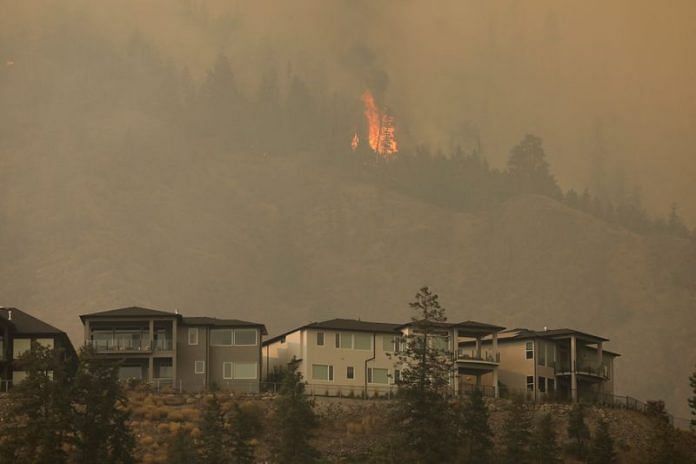REVELSTOKE, British Columbia (Reuters) -Wildfires ravaging Canada’s British Columbia province are showing some signs of easing and the weather conditions should improve through Monday into Tuesday, although crews are still battling “epic” blazes, emergency officials said.
More than 35,000 people have been driven out of their homes over the past four days as flames spread in the western region, forcing the federal government to deploy the military.
Blazes are also raging further north as Canada reels from its worst wildfire season on record, which many experts have blamed on climate change. Other fires, exacerbated by severe drought, have been reported closer to the U.S. border and in the U.S. Pacific Northwest.
“People are facing horrific situations. … This is a scary and heartbreaking time,” Prime Minister Justin Trudeau said in Cornwall, Prince Edward Island, on Monday.
Trudeau also criticized Facebook parent Meta for blocking news on its platforms, saying the flow of timely information is essential to people’s safety during natural disasters.
Jerrad Schroeder, deputy manager at the Kamloops Fire Centre, late on Sunday said he was expecting “really good” firefighting conditions over the next 24-36 hours with temperatures down in the mid-20s degrees Celsius and humidity rising.
British Columbia, which sits on Canada’s Pacific coast, could get some rains this week from Tropical Storm Hilary, which hit California on Sunday, forecasters have said.
There is a 60% chance of showers starting Monday afternoon in Kamloops, according to federal weather agency Environment Canada.
The air quality index in many fire-affected areas – including Central Okanagan, Eastern Fraser Valley, Kamloops – hit above 10 on Monday, signaling a high risk, the British Columbia government said.
About 140,000 square km (54,054 square miles) of land, roughly the size of New York state, have been scorched nationwide, with smoky haze extending as far as the U.S. East Coast. Government officials project that the fire season could stretch into autumn because of widespread drought-like conditions.
About 2,000 km to the north, a wildfire burning out of control in Yellowknife, the capital of Northwest Territories (NWT), has turned the remote city into a smoky, ghost town with almost all the of its 20,000 residents evacuated.
Some 400 armed forces personnel are helping the NWT government deal with the fire, Canada’s Department of National Defence said on Sunday. Fires continued to burn about 15 km from Yellowknife and it was unclear when they will reach the city, officials said.
Jason Brolund, fire chief of West Kelowna in British Columbia, one of the worst affected areas by the fires, said conditions have improved which is helping firefighters put “boots on the ground.”
“We haven’t been challenged with extraordinary fire behavior. We are dealing with things like we are used to seeing. However, we are dealing with them on an epic scale,” Brolund told the Canadian Broadcasting Corp.
(Reporting by Ismail Shakil and David Ljunggren in Ottawa; Writing by Denny Thomas; Editing by Michael Perry, Andrew Heavens and Mark Porter)
Disclaimer: This report is auto generated from the Reuters news service. ThePrint holds no responsibilty for its content.



